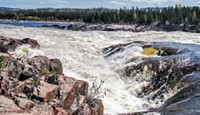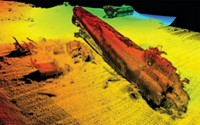Advertisement
Grab your lab coat. Let's get started
Welcome!
Welcome!
Create an account below to get 6 C&EN articles per month, receive newsletters and more - all free.
It seems this is your first time logging in online. Please enter the following information to continue.
As an ACS member you automatically get access to this site. All we need is few more details to create your reading experience.
Not you? Sign in with a different account.
Not you? Sign in with a different account.
ERROR 1
ERROR 1
ERROR 2
ERROR 2
ERROR 2
ERROR 2
ERROR 2
Password and Confirm password must match.
If you have an ACS member number, please enter it here so we can link this account to your membership. (optional)
ERROR 2
ACS values your privacy. By submitting your information, you are gaining access to C&EN and subscribing to our weekly newsletter. We use the information you provide to make your reading experience better, and we will never sell your data to third party members.
Environment
Oil Sands Extraction In Canada Leaves Mercury Footprint
Mercury Pollution: Comprehensive survey finds that elevated levels of neurotoxic methylmercury accumulate in snow around oil sands production sites
by Deirdre Lockwood
June 13, 2014
The oil sands of Canada’s Alberta province hold one of the largest known oil reservoirs in the world, with bitumen deposits estimated at more than 1 trillion barrels. But extracting and refining the bitumen emits toxic metals such as mercury and other pollutants. Researchers and environmentalists are concerned that these operations could threaten the wildlife of the Athabasca region, where most of the extraction is taking place, as well as residents who hunt and eat birds and fish from the area.

Now, in a comprehensive survey of the region, Environment Canada researchers show that Athabasca oil sands operations leave a footprint of several contaminants, including neurotoxic methylmercury, in local snow (Environ. Sci. Technol. 2014, DOI: 10.1021/es500986r). The mercury levels do not exceed those prescribed by Canadian guidelines for the protection of wildlife. However, spring snow melts could flush this mixture of pollutants into nearby rivers, potentially impacting those ecosystems, the researchers say.
The new study is a smoking gun that implicates oil sands development as the source of mercury contamination in the surrounding area, says Charles T. Driscoll, an environmental engineer at Syracuse University who studies mercury pollution.
Previous preliminary surveys of 30 sites near the Athabasca oil sands production region found elevated concentrations of more than a dozen pollutants, including mercury (Proc. Natl. Acad. Sci.USA 2009, DOI: 10.1073/pnas.0912050106; 2010, DOI: 10.1073/pnas.1008754107). But because airborne pollutants can be carried far from their sources, Environment Canada researcher Jane L. Kirk and her colleagues wanted to design a more comprehensive study to determine the spatial extent of contaminants deposited in the region.
Pollutants released through oil sands development settle out of the air and are scrubbed out through precipitation, allowing them to accumulate in the snowpack in winter. So the team collected snow in the winters of 2011 and 2012 at about 90 sites over a 20,000 km2 area. Eighty of these sites were within 100 km of the oil sands development region; the remaining sites were about 200 km away and used to determine background levels of the pollutants.
The researchers measured concentrations of total mercury and various metals in the melted snow. They also measured methylmercury, a neurotoxic form of mercury that is easily taken up by wildlife and can bioaccumulate in food webs. They calculated the amount of these pollutants that snowmelt would deliver to the surrounding area and interpolated these data to create maps of contaminant deposition.
The maps for total mercury and methylmercury show a bull’s-eye pattern of increasing levels of contaminant loads centering on the area of oil sands development. Snowmelt in these regions would deliver up to 1,420 ng of total mercury and 19 ng of methylmercury over one square meter of land, which is 10 times greater than the loads calculated for the background sites. Still, both mercury and methylmercury concentrations in snow were below wildlife protection guideline levels set by the Canadian government.
Syracuse’s Driscoll notes that the net wintertime mercury loading estimated for the oil sands region is only about 20% of that delivered annually by precipitation in rural areas of the northeast U.S. Still, he says, the elevated levels could threaten the relatively pristine ecosystems of the Athabasca region, where there are already government advisories to limit fish consumption because of the toxic metal. “Additional mercury will make an existing problem worse.”






Join the conversation
Contact the reporter
Submit a Letter to the Editor for publication
Engage with us on Twitter